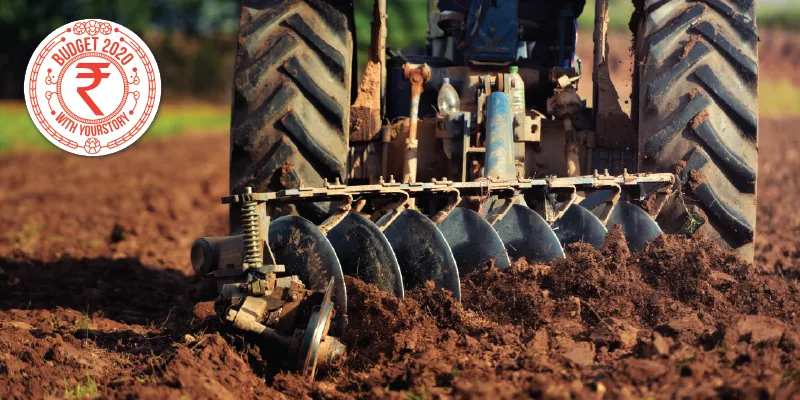Decoding Budget 2020: Startups react to agriculture reforms, schemes, and crop production proposals
This year, the Finance Minister emphasised on farmers’ distress, bringing in a 16-point action plan and various other measures to tackle the issue.
As every year, Union Budget 2020 too emphasised on farmer’s issue largely, focussing on liberalising the market, increasing farmers’ income, among others.
To counter these issues and achieve the target of doubling the farmers’ income by 2022, Finance Minister Nirmala Sitharaman proposed a 16-point action plan in this year’s Budget.

SocialStory spoke to a few startup founders, agriculture experts, and farmers to understand how the plans laid out by the government will affect the agriculture sector at large. Here’s what they have to say:
Relieving farmer distress
India is an agriculture-based economy that depends largely on the monsoon to receive its share of water for farming. Having said that, the government in this year’s Budget has proposed comprehensive measures to relieve 100 water-stressed districts.
Mallikarjun Kukunuri, CEO of Niruthi Climate and Ecosystem Services, said,
“The strategic action plan launched by the government in the Union Budget 2020 will be a path towards reviving the sector and doubling farmer's income. Increasing the allocation of funds to empower the sector will further open up new avenues for farmers to strengthen the ecosystem, contributing to India's economic growth.”
1564671114666.png?fm=png&auto=format)
Further, the government has also provided relief to the farmers by helping about 20 lakh farmers in setting up standalone solar pumps under its Pradhan Mantri Kisan Urja Suraksha Mahabhiyan Scheme.
According to official reports, the scheme has been introduced to increase farmers’ income, provide a reliable source for irrigation, and de-dieselise the agriculture sector.
Under this, the government has proposed the following components:
- To set up 10,000 MW of decentralised, grid-connected renewable energy power plants on barren lands.
- Installation of 17.50 lakh standalone solar pumps.
- To set up 10 lakh grid-connected agriculture pumps.
Provisions to enhance crop growth, allied activities
Under the PM Kisan Yojna, the Finance Minister has set the agriculture credit target for the financial year 2020-21 at Rs 15 lakh crore, where all eligible beneficiaries of PM-KISAN will be covered under the KCC scheme.
In her speech, Nirmala Sitharaman said,
“Multi-tier cropping, bee-keeping, solar pumps, solar energy production in non-cropping season, and zero-budget natural farming shall be given priority. The portal “Jaivikkheti”, which focusses on the online national organic products market, will also be strengthened. Financing on Negotiable Warehousing Receipts (e-NWR) has crossed more than Rs 6,000 crore. This will be integrated with e-NAM.”
Prakash Vaghasiya, Founder, Vise Organic, said that this year’s Budget amount for the agriculture sector is quite sufficient as compared to the previous budget allocation. The highlight of the Budget is to set up a transportation facility for farm produces by the Indian Railways. This will increase the farmers’ revenue to access the metro market.
The Budget also included the announcement of the Civil Aviation Ministry’s 'Krishi Udaan' scheme, targeted to help farmers export their produce internationally.
“MNREGS would be dovetailed to develop fodder farms. Further, we shall facilitate the doubling of milk processing capacity from 53.5 million MT to 108 million MT by 2025. Additionally, the government proposes to put in place a framework for development, management, and conservation of marine fishery resources,” Sitharaman added.
The Minister stressed on raising fish production to 200 lakh tonnes by 2022-23. This would involve youth in the fishery space through 3,477 Sagar Mitras and 500 Fish Farmer Producer Organisations. This is expected to raise fishery exports to Rs 1 lakh crore by 2024-25.
Integrating agriculture with technology
Experts also lauded the fact of integrating new-age technology with the sector, thereby helping farmers.
Mallikarjun added that the government – keeping in line with the theme of aspirational India – proposed sustainable cropping patterns coupled with new-age technology to further boost the productivity and efficiency in the agriculture value chain. He said that the liberalisation of farm markets and increased competition will prove to be a game-changer to bring back the sector on track.
One of the main focus areas for the government has been the storage of agricultural produce.

Representational Image
Sitharaman also said that the Food Corporation of India (FCI), as well as the Warehousing Corporation of India, will be supported to build warehousing facilities on their land. Additionally, NABARD will be entrusted with mapping and geo-tagging agri-warehouses across the country.
This comes at a time when the agricultural sector is experiencing huge losses due to the high cost of cold storage, improper management, unequal distribution, and non-accessibility of warehousing facilities to farmers.
Mohnish Sharma, CEO and Founder, HaraBaag, said, “The Budget indicated that the government is bringing in much needed structural reform to the agriculture sector. India has made great strides in increasing the productivity of farmers, but the post-harvest supply chain is inefficient.
The 2020 Budget proposals – the village storage scheme, mapping of warehouses, and cold-chain for perishable will be a big step forward for the industry. Additionally, enactment of the three acts (land leasing, APMC, and contract farming) will give much-needed clarity and open up opportunities to agri-entrepreneurs."
(Edited by Suman Singh)









